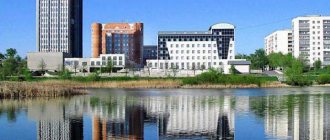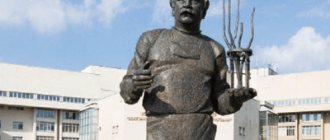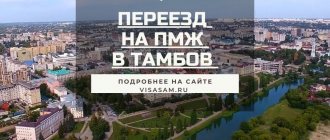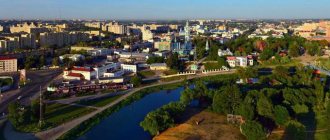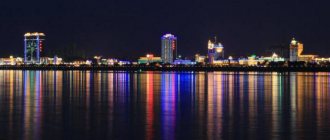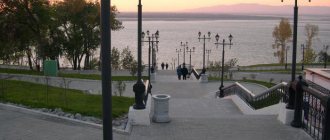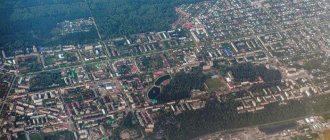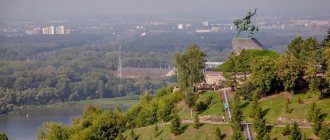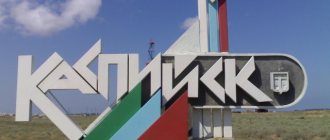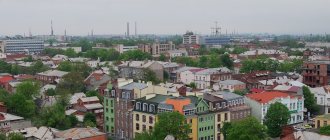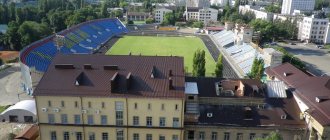City `s history
The city has an ancient history. A couple of sites from the Stone Age era (15.5 thousand years ago) were discovered here. There are also remains of Bronze Age villages. In the historical past, the first settlements appeared in the 10th century, during the formation of Volga Bulgaria. Active settlement of the area took place in the 13th-14th centuries. The city itself was built relatively recently - in 1960, which was associated with the founding of a chemical plant. Its size increased very quickly. In 1983 the population was 100,000.
General information and history of Novocheboksarsk
According to our city rating, the city of Novocheboksarsk is in the top 100 best cities in Russia and ranks 64th in it. Let's try to figure out what determines the place of the city of chemists, energy workers and builders in the ranking.
Panoramic view of the city
Perhaps we should start with his story. Novocheboksarsk appeared in the wake of the all-Union construction boom, when the Communist Party sent Komsomol construction teams to build new cities and industrial facilities throughout the country. In Chuvashia, on the banks of the beautiful Volga River, a grandiose construction of a chemical plant and a hydroelectric power station was planned. People of different nationalities, cultures and religions enthusiastically rushed to the large construction site. Since then, the main backbone of the cozy and hospitable city has been the brave romantics of Soviet times and their descendants.
The city was not founded on a wasteland; several Chuvash villages were developed. Their names are now borne by the microdistricts of Novocheboksarsk - Yurakovo, Elnikovo, Ivanovo and others.
The year of birth of Novocheboksarsk is considered to be 1960. And since then it has not stopped growing and expanding. It is separated from the capital of the republic, Cheboksary, by just over 20 km, this fact automatically included the town in satellite status. In 2008, the question of uniting the two cities was raised, but the majority of Novocheboksarsk residents (75%) were against such a decision. They were afraid that many problems would arise related to paperwork, the need for re-registration, and the city would become just a district of Cheboksary. Many were not happy that Novocheboksarsk in this case would lose its status as a city.
Geographical features
The city is located 17 kilometers from the capital of the Chuvash Republic, Cheboksary, on the right bank of the Volga. It is a significant transport and economic center. It has an important freight railway, a river port and a bridge across the Volga.
Novocheboksarsk is located in the Moscow time zone (MSK).
The city is located on a slightly hilly undulating plain, which is dissected by river valleys, streams and ravines. Landslides often occur here, with the formation of ravines, wetlands and flooding of low-lying areas.
The environmental situation in the city varies by region. In the industrial part it is significantly worse. Vehicle emissions also affect the level of air pollution.
City infrastructure
This is an industrial city, where residential areas are isolated from the industrial and communal zones by regulatory sanitary zones.
Today in the city, probably, only the lazy do not criticize the housing and communal services. But there is something to criticize for - non-transparent charges, insufficiently high quality of services. The best thing is for residents of those houses where there are active house councils. They carefully monitor all housing and communal services settlements with utility service providers.
Vodokanal in Novocheboksarsk
The state of medicine leaves much to be desired. Novocheboksarsk, unfortunately, cannot boast of either the quality of the medical services provided or the number of highly qualified medical specialists. At the first opportunity (for example, the state offered young medical workers 1 million rubles to everyone who would go to the village to work for 5 years), many medical workers leave city hospitals. Sometimes one local doctor serves several territories. The children's clinic lacks qualified specialists and there are endless queues. It can be very difficult for visitors to get an appointment with the right doctor - at the reception they give a turn away: “get treated at home.” True, you won’t hear this in a children’s clinic, but if you go to the emergency room, such a development of events can be expected.
Children's city clinic
Regarding transport, the passenger flow is handled quite well by private minibuses along with trolleybuses from the city park. There are no traffic jams and there cannot be, unless there is an accident on the road. There is a small minus - transport only works until 8 pm (private cabs), and trolleybuses run until 12 am. It’s good that the city is very small, in half an hour, maximum in an hour, you can reach its other end. True, it’s scary to walk on foot, since night lighting is only on the main streets of Novocheboksarsk. As a last resort, you can always take a taxi, since there are a large number of them in the city.
It has its own river port and cargo pier. River transport communication along the Volga River is carried out through them.
Climate
The city is located in a zone of typical temperate continental climate. Characterized by moderately hot summers and rather cold winters with unstable weather - fog, precipitation of various types and clear days. Due to climate warming, winters have become significantly milder. It is noted that the warmest weather corresponds to southern and southwestern winds, and the coldest – northern ones.
The maximum amount of precipitation falls in summer, especially in July (71 mm), and the minimum in February and March (24 mm each).
Team Nomads
Novocheboksarsk began to be built in 1960, when satellite cities were created around large cities. Initially it was called “Sputnik”. They began to build it on areas free from development. As it grew, it absorbed the surrounding villages - Elnikovo, Yandashevo, Anatkasy, Tsygankasy, etc. On December 27, 1971, the Presidium of the Supreme Soviet of the RSFSR made a gift to the people of Novocheboksarsk by issuing a Decree “On classifying the city of Novocheboksarsk of the Chuvash Autonomous Soviet Socialist Republic as a city of republican (CHASSR) subordination)” . Its territory is 36.7 sq. km.
Located 21 km from the capital of the Chuvash Republic - Cheboksary. The city limits were approved in December 1998. The economic and geographical position of both cities has much in common. They are served by common modes of transport. They have a common construction and energy base, common water supply and water treatment systems. Currently, there are close economic, cultural and everyday ties between the two cities.
ARTICLE ABOUT CHEBOKSARY RESERVOIR - HERE!
SPRINGS AND SOURCES OF CHUVASHIA - HERE!
ATTRACTIONS OF CHUVASHIA - HERE!
NATURAL MONUMENTS OF CHUVASHIA - HERE!
REPUBLIC OF CHUVASHIA - GENERAL INFORMATION - HERE!
ANOMAL AREAS OF CHUVASHIA - HERE!
RIVERS OF CHUVASHIA - HERE!
Novocheboksarsk is one of the most comfortable and beautiful cities in the republic. It was built according to the latest projects of Leningrad architects. One of its first and main thoroughfares is Vinokurova Street, on which in 1985 a monument was erected to the fighter for the establishment of Soviet power in Chuvashia I.S. Semenov. The city is also decorated with modern monuments. One of them, on Gidrostroiteley Boulevard, was erected in memory of the residents of villages that were previously located on the site of Novocheboksarsk who died during the Great Patriotic War. The second is the Church of the Holy Equal-to-the-Apostles Prince Vladimir, First Baptist of Rus'. The city was built and expanded at a very fast pace. Already in 1978, a meeting was held dedicated to the commissioning of the first million square meters of housing, and five years later, on October 29, 1983, the hundred thousandth resident was born. The city is divided into 3 residential areas: East, South, West. There are 18 microdistricts.
CHRONICLE OF THE CITY On November 18, 1960, a team of concrete workers from V.N. Nikiforov “Stroytrest N4” laid the first cubic meters of concrete in the foundation of the first house (now house No. 18 on Kommunisticheskaya Street.) This street did not immediately receive this name. On July 5, 1962, the Executive Committee of the Cheboksary City Council decided: “The first street, built up with multi-storey buildings parallel to the protective zone from the brick factory in the city of Sputnik (New Industrial District), should be named after Kurchatov, the famous atomic physicist, and henceforth be called Kurchatov Street.” And only on July 12, 1962 In 2009, the Cheboksary City Executive Committee decided “to change the previously made decision, to name the first street in the Novopromyshlenny district Kommunisticheskaya.” The grand opening of the first street took place. Our city originates from it. Here, almost every building is given the epithet “first”: the first house and the first school, the first club and the first library, the first bathhouse and the first restaurant, the first city market and the first passenger depot, etc. In those distant 60s, when Novocheboksarsk was not yet on geographic maps, people dreamed of a new, beautiful, bright, comfortable city. And their dream became clear. The city of Sputnik was being built and taking on visible shape. Working, energetic people carried it into orbit with reliable, tireless hands. Novocheboksarsk, which arose as part of the city of Cheboksary, was its satellite for the first 5 years. July 6, 1965. The Bureau of the Chuvash Regional Committee of the CPSU adopted a resolution “On the formation of the city of Ilyichevsk of republican (ASSR) subordination,” providing for the formation of a chemical plant on the right bank of the river on the basis of a residential area. Volga of the city of Ilyichevsk. On August 11, 1965, the Bureau of the Chuvash Regional Committee of the CPSU adopted a resolution “On the creation of the city of Novocheboksarsk” which, in particular, stated: “In amending its resolution of July 6, 1965, the regional committee bureau decides: 1. On the basis of the Novocheboksarsk district, to form the city of Novocheboksarsk city Cheboksary subordination." On August 11, 1965, the Presidium of the Supreme Council of the Czechoslovak Autonomous Soviet Socialist Republic adopted a resolution “On the formation of the city of Novocheboksarsk in the Chuvash Autonomous Soviet Socialist Republic,” which abolished the Bannovsky village council of Cheboksary, transferring the settlements of Bannovo, Ivanovo, Oldeevo, Tenekassy, Chedino and Yandashevo to the administrative subordination of the Novocheboksary city council. September 27, 1965. The Presidium of the Supreme Soviet of the RSFSR adopted the Decree “On the transformation of a village during the construction of a plant in the suburban area of the city of Cheboksary of the Chuvash Autonomous Soviet Socialist Republic into a city of district subordination.” December 27, 1971. The Presidium of the Supreme Soviet of the RSFSR adopted the Decree “On classifying the city of Novocheboksarsk to the category of cities of republican (ASSR) subordination.” In 1977, an art school was opened at secondary school No. 6. There are 160 students studying in its three departments of choreography, art, and music. In 1979, a furniture repair and manufacturing factory was opened. In 1980, the opening of the first stage of the Novocheboksarsk sports complex took place. In 1988, a bus station was opened in the Elnikovsky microdistrict, which has convenient exits to main highways. In 1992, the first library of national and spiritual revival in the republic was opened. Visitors can not only get acquainted with the latest books, but also watch performances of folklore ensembles recorded on a video recorder. In September 1992, Russian President B.N. Yeltsin visited the city.
2003 On February 24, 1993, by decision of the city Council of People's Deputies, the coat of arms of the city of Novocheboksarsk, artist V.I. Razin, was approved. The coat of arms of the city of Novocheboksarsk is an image of a golden bordered heraldic shield with red stylized ornamental Chuvash symbols. The coat of arms is crowned with the “three suns” emblem, which symbolizes belonging to the Chuvash Republic. The ornamental symbolism in the center figuratively expresses the owner of the city, chemists and electric power workers. The shield is bordered with azure color. 2005 By the decision of the Novocheboksarsk City Assembly of Deputies dated February 9, 2005, a new coat of arms and flag of Novocheboksarsk were approved. Heraldic description of the Coat of Arms: In an intersected field of azure and green, there is a wide lowered golden rafter, burdened with three flying azure ducks holding green oak branches in their beaks. Heraldic description of the Flag: A rectangular yellow panel with a height to length ratio of 2:3. Adjacent to the upper corners are two blue fields in the shape of right triangles, the legs of which are the sides of the panel (the length of the legs: along the top edge of the panel - 1/2 the length of the panel, along the side edges of the panel - 2/3 of the height of the panel). Adjacent to the bottom edge of the panel is a green field in the shape of an isosceles triangle, the base of which is the bottom edge of the panel, the sides are parallel to the hypotenuses of the blue fields, the top is located on the vertical axis of the panel, and the height is 1/3 of the height of the panel. On the yellow part of the panel there are three azure ducks flying towards the tree, holding green oak branches in their beaks: one in the center and two below it, close to the lower corners of the panel. On March 23, 2005, the city's coat of arms and flag were entered into the State Heraldic Register. Until 2010, City Day was celebrated on November 18. By decision of the Novocheboksarsk City Assembly of Deputies dated July 19, 2010 No. C 82-2, a new official annual date for the City Day of Novocheboksarsk was determined; from 2010, the City Day of Novocheboksarsk will be celebrated on the third Saturday of September.
GENERAL INFORMATION Novocheboksarsk (Chuvash. Ҫӗнӗ Shupashkar) is a city in the Chuvash Republic in the Russian Federation.
The population of the city is 125,489 people. (2016). The population of the urban district is 125,797 people. (2016).
Located 17 km from the capital of the Chuvash Republic - Cheboksary, on the right bank of the Volga River. It has an advantageous transport and geographical position, since the dam of the Cheboksary hydroelectric power station also serves as a road bridge (put into operation on July 29, 1994) providing communication with Yoshkar-Ola, Kazan and other cities in the northern part of the Volga-Vyatka region. The city has its own river port, which carries out freight and passenger transportation. The freight railway turned Novocheboksarsk into one of the major economic centers on the Volga.
The city limits were approved in December 1998. The city is divided into three residential areas: East, South, West. There are 18 microdistricts.
On March 2, 2008, a referendum was held to unite the cities of Cheboksary and Novocheboksarsk into one urban district. The majority of Novocheboksary residents voted against the unification.
GEOGRAPHY OF THE CITY The city of Novocheboksarsk with the entire complex of industrial enterprises is located on the right bank of the Volga River, within the interfluve of the Tsivil and Kukshum rivers. The channel of the latter limits the territory from the west and south, the northern border is the Volga River, and the eastern border is the Tsivil River. The area of the city is 51.4 square kilometers. Novocheboksarsk has a favorable geographical position, located 14 km. from the capital of the Chuvash Republic - Cheboksary. In the vicinity of the city there are significant deposits of brick and expanded clay raw materials, construction sands, and peat, which favors the development of the building materials industry. The climate of the city is temperate continental with all its inherent features: moderately hot summers and cold winters with unstable weather, with frequent precipitation in the form of rain and snow, fog and sunny days. In summer the temperature on average reaches 25-35 degrees, in winter – 20-25 degrees. However. Every year winter becomes milder, heat is mainly carried by southern and southwestern winds, rain and cold are carried by northern and northwestern cyclones. The relief is an undulating, sometimes hilly plain, dissected by the valleys of the Kukshum rivers, streams and numerous ravines. Exogenous geological processes are developed in the city area: gully formation, landslide processes, waterlogging, flooding of low-lying areas. The city has a favorable transport location.
The latitudinal city-wide highway connecting the city of Novocheboksarsk with the city of Cheboksary goes out onto the federal highway “Vyatka”, which connects Chuvashia with the Republic of Mari-El. The same road provides the shortest route from Novocheboksarsk to other federal highways: Volga and Tsivilsk - Ulyanovsk. Transport communication with the neighboring Marposad district is carried out along the main republican highway Novocheboksarsk - Marposad - Volga. The nearest railway stations of the Gorky Railway Administration are Art. Cheboksary and st. Kanash. The railway access from the industrial zone of Novocheboksarsk is adjacent to the Kanash-Cheboksary line. In the industrial zone there are stations. Industrial and Art. Passenger Street, which is adjacent to the access roads of city enterprises. There are no railway approaches to the quay walls of enterprises located along the Kuibyshev Reservoir. River communication along the Volga River and reservoirs is carried out by the Cheboksary river port within the boundaries of Ilyinka-Kozlovka. Suburban, intracity and intercity passenger services have been organized. The cargo area of the Novocheboksary port with berth walls 208 meters long is located 3 km below the Cheboksary hydroelectric station. The main cargo arriving by water transport is inert building materials, sand, crushed stone, gravel for road and construction work not only in the Chuvash Republic, but also in other neighboring regions.
HISTORY OF THE CITY The land occupied by Novocheboksarsk has an ancient history. In this area, archaeologists discovered two sites of ancient people dating back to the Stone Age - the Mesolithic (13.5 thousand years BC) and the Neolithic (4-3 thousand years BC). The first parking lot is located along the left bank of the river. Tsivil - former village. Yandashevo (now within the city), the second is above the mouth of the river. Civil on the banks of the Volga (village of Ivanovo).
There are Bronze Age mounds near the villages of Yurakovo and Bannovo (now within the boundaries of Novocheboksarsk). There was a Bronze Age settlement near the village. Yandashevo.
According to archaeological data, along the river. Great Civil Chuvash villages began to appear in the 10th century. - the time of the formation of Volga Bulgaria. In the XIII-XIV centuries. There was a continuous settlement of the basin of the Greater and Lesser Civilizations by the Bulgaro-Chuvash.
Novocheboksarsk began to be built in 1960 in connection with the construction of a chemical plant. With the growth of the city, surrounding villages were included in it - Bannovo, Elnikovo, Yandashevo, Anatkasy, Tsygankasy, Ivanovo, Chedino, Yurakovo and a number of others. The city's birthday is considered to be November 18, 1960. Initially they wanted to name the city Ilyichevsk, but on August 11, 1965, the Presidium of the Supreme Council of the Chuvash Autonomous Soviet Socialist Republic adopted a resolution “On the formation of the city of Novocheboksarsk in the Chuvash Autonomous Soviet Socialist Republic.” On September 27, 1965, based on the Decree of the Presidium of the Supreme Soviet of the RSFSR, Novocheboksarsk received city status. On December 27, 1971, the Presidium of the Supreme Soviet of the RSFSR issued a Decree “On classifying the city of Novocheboksarsk of the Chuvash Autonomous Soviet Socialist Republic as a city of republican (CHASSR) subordination.”
The city was built and expanded at a very fast pace. Already in 1978, a meeting was held dedicated to the commissioning of the first million square meters of housing, and five years later, on October 29, 1983, the hundred thousandth resident was born. The city of Novocheboksarsk, like the entire Chuvash Republic, is located in a time zone designated by international standard as the Moscow Time Zone (MSK). The offset relative to UTC is +3:00. Time in Novocheboksarsk corresponds to geographic standard time. Climate The climate of the city is temperate continental with all its inherent features: moderately hot summers and cold winters with unstable weather, with frequent precipitation in the form of rain and snow, fog and sunny days. In summer the temperature on average reaches 25-35 degrees, in winter - 20-25 degrees. Every year winter becomes milder, heat is mainly carried by southern and southwestern winds, rain and cold are carried by northern and northwestern cyclones. Coat of arms of Novocheboksarsk The author of the coat of arms of Novocheboksarsk is local heraldist Vadim Anatolyevich Shipunov. The coat of arms was approved on February 9, 2005 and entered into the State Heraldic Register under No. 1799.
“A golden rafter laden with three flying ducks holding green oak branches in their beaks.”
1993 The previous coat of arms of the city was approved in 1993.
“The coat of arms of the city of Novocheboksarsk is an image of a golden bordered heraldic shield with red stylized ornamental Chuvash symbols. The coat of arms is topped with the “three suns” emblem, which symbolizes belonging to the Chuvash Republic. The ornamental symbolism in the center figuratively expresses the mistress of the city of chemists and electric power workers. The shield is bordered with azure color" (description of the coat of arms). The author of the coat of arms is V. I. Razin.
Flag of Novocheboksarsk Heraldic description of the Flag: “A rectangular panel of yellow color with a height to length ratio of 2:3. Adjacent to the upper corners are two blue fields in the shape of right triangles, the legs of which are the sides of the panel (the length of the legs: along the top edge of the panel - 1/2 the length of the panel, along the side edges of the panel - 2/3 of the height of the panel). Adjacent to the bottom edge of the panel is a green field in the shape of an isosceles triangle, the base of which is the bottom edge of the panel, the sides are parallel to the hypotenuses of the blue fields, the top is located on the vertical axis of the panel, and the height is 1/3 of the height of the panel. On the yellow part of the panel there are three azure ducks flying towards the tree, holding green oak branches in their beaks: one in the center and two below it, close to the lower corners of the panel.” (flag description).
Industry Novocheboksarsk is a modern city of chemists, energy workers and builders. The leading city-forming enterprise is the joint-stock company "Khimprom". For almost two decades, the Cheboksary hydroelectric power station, built on the Volga, near the city, has been operating, generating electricity for the republic and neighboring regions. The industrial potential of Novocheboksarsk includes 219 enterprises of all forms of ownership, including 18 main ones.
The city has a well-developed construction complex, which at one time made it possible to build not only Khimprom and the Cheboksary hydroelectric power station, but also modern residential areas with developed social infrastructure. Its housing stock alone amounts to 2 million square meters.
In recent years, in Novocheboksarsk, as well as throughout the republic, processes of economic reform, its structural restructuring are actively underway, and market relations are strengthening. Industrial enterprises, primarily JSC Khimprom and the Cheboksary Hydroelectric Power Station, are overcoming the economic difficulties associated with the new form of management. Production is reviving and production is increasing. Small businesses are also developing, and there are more entrepreneurs every year. Transport The Novocheboksarsk-Cheboksary-2 freight railway, the federal road P176 “Vyatka”, as well as the shipping route along the Volga River pass through the city. In the industrial zone there are stations. Industrial and Art. Passenger Street, which is adjacent to the access railway tracks of city enterprises. Transport communication with the neighboring Marposad district is carried out along the main republican highway Novocheboksarsk - Marposad - Volga. The fare for electric transport is 16 rubles, and for minibuses within the city - 20. The main transport institutions of the city are:
central bus station, river station, railway freight station[], LLC "Commercial route transportation" Novocheboksarsk municipal unitary enterprise of trolleybus transport[], Novocheboksarsk PATP (branch of the State Unitary Enterprise "Chuvashavtotrans"). Culture and art To satisfy the spiritual needs of residents, the city has 20 cultural facilities. The largest of them is the Khimik Palace of Culture with an auditorium for 800 seats, which opened on November 2, 1971.
House of Culture Khimik Children's art school Art school Music school Elnikovskaya Roshcha recreation park Theaters and cinemas Atal cinema Chuvash State Experimental Drama Theater Mime Theater "Rain" Cinema "Teterin Film" (opened on January 1, 2016 on the site of the previously closed in September 2015 at the Atal cinema) Libraries Central City Library named after. Yu. Gagarin Library named after. N. I. Polorussova-Shelebi Library named after. P. Khuzangaya (branch No. 2) Family Reading Library named after. A. Nikolaev Family Reading Library named after. S. Ya. Marshak Children's and Youth Library Library named after. N. Nosov Family Reading Library named after. V. I. Davydova-Anatri Museums Art Museum Founded in 1983 as an exhibition hall. In 1996, the exhibition hall was transformed into the municipal cultural institution “Art Museum”. The museum fund includes 651 works by Russian artists. The museum fund consists of 843 storage units: painting, graphics, sculpture, decorative and applied and folk art. The museum offers visitors tours of exhibitions, lectures on art, the history of the city, and its pioneers. It also conducts professional meetings “Secrets of Craft” with masters of fine art and folk craftsmen, as well as poetic, musical and literary evenings. Museum of the History of Novocheboksarsk Founded in 2008. A young developing city with an already established rich history has something to tell and show in the exhibitions of the new museum. The administration and archive of the museum are located on the ground floor of the building, and exhibitions are located above. The history of Novocheboksarsk is presented in three halls, which represent the past, present and future of the city. Religion The predominant denomination is Orthodoxy
Russian Orthodox Church Cathedral of St. Prince Vladimir Equal to the Apostles (1994, architect A. B. Oreshnikova) Temple of St. Nicholas the Wonderworker (under construction, active) Islam Construction of a mosque is underway in the Ivanovo microdistrict Architecture and attractions Over 20 monuments of monumental art have been installed in Novocheboksarsk. Among them:
Monument to the residents of villages that were previously located on the site of the city of Novocheboksarsk who died during the Great Patriotic War (1985, architect B. Shimarev) - on a granite pedestal there is an embossed bas-relief of a victorious warrior. Bronze, granite, and copper were used in the work. Obelisks in Oldeevo, Ivanovo, Toksineevo and Bannovo. Monument to Prince Vladimir (2003, architect M. Vinogradov) - a five-meter figure of Prince Vladimir is installed on a one-meter granite pedestal; on the pedestal there is a memorial plaque with the words: “Holy Equal-to-the-Apostles Prince Vladimir, Baptist of Rus'.” Material: forged copper. A stela in honor of the first builders of the city (2000, architect Alexander Ilyin) - five peaks symbolizing a hand, connected by a blue ribbon on which are written the words from the song “The main thing, guys, is not to grow old with your heart!”, and a guitar is depicted - an indispensable attribute of youth 60-70 gg. Obelisk in honor of the soldiers who fell during the Second World War (renovated in 2002) - an obelisk in the form of a cross, made of granite. Monument to soldiers who took part in local wars and military conflicts (2006, sculptor P. Pupin) - a bronze soldier with a machine gun in his hand against the backdrop of two symmetrical marble obelisks with the names of the heroes of the city. Monument to the communist Ivan Semyonov (1985, architect B. Shimarev) - engraved on the granite tombstone: “Ivan Semyonov (1.3.1887 - 2.7.1919). An active fighter for the establishment of Soviet power in Chuvashia. The first chairman of the executive committee of the Alymkasinsky volost council of peasant deputies. Killed by counter-revolutionaries. Born in the village of Elnikovo. The monument is made in bronze, a bas-relief of the hero against the background of a banner with the inscription “All power to the Soviets.” Decorative and monumental composition in honor of the founding of the city of Novocheboksarsk (2003, designer V. Troitsky) - The composition is made of stainless steel.
Along the circumference of the ring there is an inscription in Chuvash and Russian: “The city of Novocheboksarsk was founded in 1960.” The spire of the composition is crowned with a model of an atom glowing in the night, symbolizing the city-forming enterprise of JSC Khimprom and the basis of the whole world. Sculpture of a young woman with a baby (2006, author A. Zotikov). The sculpture is made of bronze. Statue of a Worker (1965, unknown author) - a statue of a young man with an athletic build is installed on a high pedestal. With his right hand he holds a hammer, from the hammer there is a crescent-shaped trail from the satellite. Fountain “In Memory” in honor of the 13 villages that became part of Novocheboksarsk (2003, architect N. Rozhkova) - on the edges of the fountain are the names of the 13 villages on which modern Novocheboksarsk is based. Each stream resembles a candle. Water - tears, candles - memory. A people has no future without a past. Monument to the victims of the Chernobyl nuclear power plant and other man-made disasters (2003, sculptor M. Vinogradov) - on a granite pedestal there is a “fire burning”, a drop of blood melts in the fire, pierced by three rays of radiation (alpha, beta, gamma). Material: forged copper. Monument to Soldiers - Internationalists (2000) - the monument is an armored personnel carrier mounted on a two-meter pedestal. On the pedestal there is the inscription “Glory to the warrior - the winner.” The armored personnel carrier is provided by the military department of the Chuvash State University.
Sport
Central Stadium named after. A. G. Nikolaeva The largest sports facilities in the city:
Khimprom Sports Complex Central Stadium named after. Nikolaev Ice Palace "Sokol" Sports complex "Dolphin" Sports complex TsRTDiYu Swimming pools - 7 Hippodrome The city is home to the hockey club "Sokol", which plays in the First League of the Russian Championship - Volga Region. The city is also represented by the Sokol volleyball team, playing in the first league, and 3 football teams representing the city at the Chuvashia Football Championship, these are Georg-Sputnik, Sputnik Youth Sports School No. 1, FC Box and FC ZARYA (Veterans). Communications and telecommunications There are 4 cellular operators in the city: MTS (Mobile Telesystems OJSC), Beeline (VimpelCom OJSC), Tele2 Russia (T2 Mobile LLC)[] and Megafon-Povolzhye. Main communication standards: GSM (2G), UMTS (3G) and LTE (4G).[]. Landline telephony services are provided by PJSC RosTelecom, LLC NKTV, LLC Infolink, JSC Infanet, LLC Informtechnology (PJSC VimpelCom) and LLC NetByNet (PJSC Megafon). The fixed-line numbering of Novocheboksarsk is six-digit, the city code is 8352. Cable and digital television services are provided by NKTV (Tsifra-TV), Rostelecom, Er-Telecom, Infolink, NetByNet (ChebNet, Wifire) The main companies providing Internet access: LLC " NKTV (NovoNet), NetByNet LLC (ChebNet, Wifire), Rostelecom PJSC (J-Internet), Infolink LLC, ER-Telecom JSC (DOM.ru) and Scartel LLC (Yota) . The transmission of backbone Internet traffic is carried out by PJSC MegaFon (formerly MSS-Povolzhye), PJSC Start Telecom (MTT Group LLC), PJSC Vympel-Communications (formerly Golden Telecom) and PJSC Rostelecom.
MUSEUM OF NOVOCHEBOXARSK On April 20, 1983, the largest exhibition hall in the Volga region was opened in the city of Novocheboksarsk - a branch of the Chuvash Art Gallery. The initiator of the creation of this unique room, intended for exhibiting works of fine art, was the Honored Architect of Chuvashia Boris Mikhailovich Shimarev. The first director of the exhibition hall for a long time was Leonid Nikolaevich Elle, who did a lot for the development of artistic art in our city.
The first exhibition was the exhibition “The Union of Artists of Chuvashia – 50 Years”, from the funds of the Chuvash Art Gallery, which functioned from April 20 to June 17, 1983. Famous artists took part in the exhibition: R.F. Fedorov, V.I. Ageev, N.E. Belotserkovsky, F.P. Osipov, N.V. Ovchinnikov, N.P. Karacharskov, V.L. Nemtsev and others. 138 works were presented - painting, sculpture, graphics. In 1996, the branch was transformed into the municipal institution “Art Museum”. The museum has become a real center of spirituality and culture in the city of Novocheboksarsk. This is the tenth year that the creative team has been headed by Yuri Pavlovich Glushachenkov. The museum has a club called “Friends of the Art Museum,” which unites all the creative people of our city. Chairman of the club - Ilyin Alexander Vladimirovich: artist, entrepreneur, philanthropist. The mission of the museum is: collecting, researching and promoting works of artists and folk craftsmen who have ever lived and are currently living in the territory of the city and the Chuvash Republic; preservation of the creative spirit of the people who built and inhabit the city of Novocheboksarsk. The museum fund consists of 651 works by Russian artists, which were donated to the city of Novocheboksarsk by the Union of Artists of the RSFSR in 1987. Currently, the museum collection consists of more than 800 storage units: paintings, graphics, sculpture, decorative and applied and folk art. The museum offers visitors tours of exhibitions, lectures on art, the history of the city, and its pioneers. It also conducts professional meetings “Secrets of Craft” with masters of fine art and folk craftsmen, as well as poetic, musical and literary evenings. Museum staff are collecting material to create a permanent exhibition about the pioneer builders and cultural workers of Novocheboksarsk. A glorious tradition in the life of the Art Museum of our city has become the custom of ending the calendar year with the art exhibition “Novocheboksary Palette” - a real celebration of fine art. Novocheboksarsk, 429951, b. Hydrostroiteley, 4 t: 73-00-57
CHEBOKSARY RESERVOIR
The Cheboksary Reservoir is one of the reservoirs of the Volga-Kama cascade, located on the Volga River, in the territories of the Chuvash Republic, the Mari El Republic and the Nizhny Novgorod region.
Formed by the dam of the Cheboksary hydroelectric power station, located in the city of Novocheboksarsk (Chuvash Republic). Filled in 1980-1982. Area 2190 km², length 341 km, greatest width 16 km, depth up to 35 m.
Large bays along the valleys of the Kerzhenets, Sura, and Vetluga rivers. On the Cheboksary reservoir are the cities of Nizhny Novgorod, Kozmodemyansk, Cheboksary. Motor tourist routes Moscow - Astrakhan, Moscow - Rostov-on-Don, Moscow - Perm, etc. pass through the reservoir.
map of the reservoir at the junction of Mari El and the Nizhny Novgorod region
The ancient Russian village of Korotni fell into the flood zone of the reservoir. Cheboksary Reservoir: fishing The reservoir is attractive primarily for lovers of fishing, which is possible here all year round. It’s interesting: what harms agriculture is of great help to fishermen. Rotting tree trunks and wetlands are a favorite habitat for some species of fish. The Cheboksary Reservoir is a habitat for pike, asp, pike perch, perch, etc. They are readily caught with wobblers or unhooked baits. They are most convenient to use so as not to damage the gear on trees or collect debris during fishing. The most successful places for fishing are the surroundings of the Makaryev Monastery, where there are a lot of predatory fish. Perch and pike gather in large schools at the mouth of the Kerzhenets River and it is convenient to catch them there with a spinning rod. The right tributary of the Volga, the Sundovik River, is a favorite place for several species of pike. And fishing enthusiasts note that in these places you can catch the entire flock of these predators.
view of the Volga near Mount Alamner - Mari El
Tourism There are several recreation centers on the territory of the reservoir, each of which offers a wide range of services for fishermen. This is a rental of space, gear and other equipment. Also, each of the fishermen can prepare their own catch. The level of comfort in places of residence - from houses with amenities to simple places with tents and campsites. Some recreation centers hold regular thematic lectures for fishing enthusiasts. The Cheboksary Reservoir is visited by a large number of people every year.
_____________________________________________________________________________________
SOURCE OF MATERIALS AND PHOTO: Team Nomads. A city built by friendship. Novocheboksarsk: events, facts, memories, photographs / comp. : A. V. Vyikin. - Cheboksary: Chuvash Book Publishing House, 2004. - 343 p. : ill. https://foto.cheb.ru/foto/34410.htm The pearl of the Volga cities: a brief encyclopedia of the city of Novocheboksarsk / (edited by R. S. Aleksandrova-Altina). - Cheboksary: New Time, 2010. - 238 p. : photos, drawings, coats of arms. Zakharov D. A. The city of Novocheboksarsk: historical essay. 1960-2005 / D. A. Zakharov, E. V. Kasimov, E. P. Pogodin; thin : O. A. Ulangin. — Cheboksary:
Chuvash State Institute of Humanities, 2006. - 254 p. : color ill., photo. Ivanov V.P., Nikolaev V.V., Dimitriev V.D. Chuvash: ethnic history and traditional culture. Cheboksary, 2000. https://ok.ru/
| The attachment | Size |
| 897.28 KB | |
| 173.63 KB | |
| 171.13 KB | |
| 219.47 KB | |
| 160.81 KB | |
| 189.38 KB | |
| 179.37 KB | |
| 140.6 KB | |
| 61.88 KB |
Population of Novocheboksarsk
This city is not very large. In 2022, the population of Novocheboksarsk was 126,072 people. The rapid growth of this indicator continued until 1990, after which it was replaced by a relatively stable state with minor fluctuations. Since then it has remained virtually unchanged.
In terms of population, the city of Novocheboksarsk is in 132nd place among the cities of the Russian Federation. Within Chuvashia, it ranks second after the administrative center.
The most common nationality in the population of Novocheboksarsk are Chuvash. Next come the Russians, and then the Tatars. Among other townspeople there are Ukrainians, Belarusians, Maris and many others.
What is Novocheboksarsk famous for?
- In the city of Novocheboksarsk, on Cathedral Square there is a monument to Prince Vladimir, dedicated to the Baptist of Rus'. The monument is made of bronze. The height of the monument reaches 5 m.
- In 1967, construction began on the Cheboksary hydroelectric power station, which is part of the Volga-Kama cascade. The approximate capacity of the hydroelectric power station reaches 1,370 MW.
- In 2006, a monument to those killed in local conflicts was opened in the city. The monument is made of bronze and granite. The author of the project was P. Pupin.
- Among the churches in the city of Novocheboksarsk, it is necessary to highlight the Cathedral of St. Prince Vladimir. The temple consists of three thrones. In 1994, the cathedral was consecrated in honor of St. Nicholas the Wonderworker. In 1996, the main Altar was consecrated in honor of St. Prince Vladimir.
- On Vinokurova Street there is a museum of local lore and history of the city of Novocheboksarsk. Here museum visitors can get acquainted with the history of the city and its surroundings. The museum contains local history and art exhibitions.
- In April 2003, a monument to the liquidators of the Chernobyl nuclear power plant accident was erected in the city. The monument is made of forged copper. The author of the project and sculptor is M. Vinogradov.
- In the premises of the Cheboksary hydroelectric power station there is a museum of hydropower. Visitors can learn about the history of hydropower in the USSR, as well as the history of the construction of hydroelectric power stations.
- In 1995, the Elnikovskaya Grove cultural and recreation park opened in the city. It contains unique vegetation, playgrounds, and attractions. In the winter you can go skiing in the park, and in the summer you can ride horses.
- Near the park there is a petting zoo. The number of animals in the zoo is constantly increasing. So, among the animals you can find a wolf, an oni, a guinea fowl, a turkey, a turtle, a wild boar.
Population dynamics of Novocheboksarsk in recent years
In recent years, the number of residents has not changed very significantly. The range of fluctuations was from 124 to 127 thousand people. From 2006 to 2009 there was an increase in population from 125,500 to 127,200 people. However, in 2010 it fell sharply and amounted to 124,097. From 2010 to 2014 inclusive, the number of residents remained approximately constant. However, then growth began, and in 2022 there were 2 thousand more residents in the city. It turns out that, despite the economic crisis of recent years, the population, on the contrary, began to grow.
Crime
It would be difficult to find a quieter city. At least in the evening you don’t have to sit at home and quietly tremble from the fear of encountering street crime. Yes, serious crimes occur, but they are very rare. Fraud, involvement in prostitution, extortion, robbery, economic crimes (selling counterfeit money, embezzlement, bribery) - this is the main list of violations that often appear in local newspaper crime chronicles.
It is no secret to respectable residents of Novocheboksary that there are many drug addicts in the city. In search of money for a dose, they are not averse to even killing a person.
In 2009, the city was shocked by the brutal murder of a local taxi driver. Two young residents of Novocheboksarsk committed a robbery against a taxi driver in order to take possession of the car. Armed with an air pistol and a knife, late in the evening they approached a parked car and offered the driver a ride to the village of Novoye Atlashevo. On the way, the attackers shot the unfortunate man in the head, stabbed him several times, and set the car and the dead man on fire. She was later found in a nearby ravine. The criminals received 14 and 17 years each.
From time to time, rumors spread among Novocheboksary residents about a maniac who has emerged, raping underage girls and attacking lonely women on the street. Unrest among the population begins after someone is raped in a drunken company. So hasty versions about a maniac appear. Usually rumors remain rumors. The official information on this matter is as follows: all persons who are prone to violent acts of a sexual nature remain under constant surveillance by police officers.
Economy of the city
Novocheboksarsk is distinguished by a highly developed industrial sector. Energy, chemistry and the construction industry are its kind of skeleton. The most significant enterprise is Khimprom. The most important energy facility is the Cheboksary hydroelectric station, which also works for neighboring regions. In total, there are 219 enterprises in the city, including 18 basic ones.
Construction is also one of the most important areas of the city’s economic life. Thus, 2 million sq. m. were built. m of housing, modern residential areas, developed infrastructure, as well as the Cheboksary hydroelectric power station and enterprise buildings.
Economic development here follows the path of developing market relations and structural restructuring. This creates additional difficulties for businesses. However, there is an increase in production and output. The role of small businesses in the city is increasing and the number of entrepreneurs is growing.
Districts and real estate of Novocheboksarsk
Today the city is divided into three residential areas (South, East, West) and an industrial zone. Each of them is further subdivided into 18 microdistricts. Let's consider only the most significant of them.
Map of the city of Novocheboksarsk
Yurakovo
Quite a prosperous area of Novocheboksarsk. It cannot be called prestigious, like no other area of the city. Yurakovo begins right at the entrance to the city, with panel high-rise buildings that stand along the road like a concrete guard. Spacious and cozy area. The bulk of the city's residents are concentrated here. It makes a pleasant impression with its still new high-rise buildings; there are also five-story buildings from Khrushchev's times, with clean, well-groomed courtyards.
New houses are built here and there periodically in accordance with new trends in construction. Shops, shopping centers, kindergartens, and entertainment venues are opening. True, recently the courtyard areas have begun to be compacted, with the construction of another new house there. Local residents are trying to resist this, complaining even to the president of the republic, but no one hears them. Local construction continues, robbing children of space for games and sports.
Yurakovo
As for housing prices, we can say that the spread in them is insignificant. For example, a one-room apartment in a new panel building costs 1,700,000 rubles, and a one-room apartment in a brick building costs just over 2,000,000 rubles.
The Hungarian Quarter microdistrict belongs to Yurakovo. At the end of April 2007, OJSC Mortgage Corporation of the Chuvash Republic, the Federal Agency for Housing Mortgage Lending and the construction industry (Hungary) entered into a cooperation agreement. And now, on the site of the wasteland, a small district grew up. It consists of several multi-storey panel buildings. Mostly residents were resettled here from houses classified as “demolition”, “mortgage holders”, and those on the waiting list. Houses were built with gross violations, as builders were in a hurry to quickly report to the government. But they built a super playground, which the local kids loved. Housing prices are around 34 thousand per sq.m.
Hungarian quarter
Another microdistrict is at the project stage - the 9th Western Residential District, which will be adjacent to Yurakovo. It is planned to build a new residential complex on an area of 28.99 hectares of land. 7-12 storey residential buildings, a kindergarten for 140 places, a public entertainment center, a secondary school for 800 places with a swimming pool - these are the main objects of the future microdistrict.
A small cottage community in the area of Pionerskaya and Solnechnaya streets. This is a street consisting of 2-story houses with a basement. They all have the same layout - “two from a casket”. On the ground floor there is a sauna and a gym, on the 1st floor there is a living room, on the 2nd floor there are 5 rooms. There is a built-in garage. The houses are built of brick. The cost of the cottage is more than 6,000,000 rubles. A cottage with an area of 250 sq.m. stands on a plot of 7.5 acres. The owner of the land plot is the municipality of the city of Novocheboksarsk.
Cottage community in Novocheboksarsk
On a plot of about four hectares, a mini-district was built, the territory of which is limited by Vinokurova Street, Stroiteley Street and the garden of the city hospital. It is planned to place a parking lot for 200 cars, cafes, shops, a kindergarten for 140 places, and a small park. Price per square meter - from 40 thousand rubles. Residents of Novocheboksarsk are indignant that the prices are unacceptable for a small town, however, there are many who want to settle here.
The advantage of living in the Yurakovo microdistrict:
- spacious, clean, comfortable;
- many schools, kindergartens, shopping centers.
Flaws:
- high housing prices compared to other districts of the city.
The city clothing market is located in Yurakovo. It is relatively small, and accordingly, the range of goods is not very diverse. For more serious goods, Novocheboksary residents go to Cheboksary.
Elnikovo
Elnikovo is a microdistrict that arose on the site of the Chuvash village of Elnikovo. High-rise buildings interspersed with five-story buildings of the Khrushchev design are the usual gray picture. The roads here leave much to be desired, except that the asphalt on the main streets is a little fresher than in the courtyards. The playgrounds have not seen a major renovation for a long time: the swings squeak sadly in time with the movement. The peeling paints on the children's equipment evoke melancholy and cause bewilderment - the area is located in Novocheboksarsk, and the picture looks as if it was cut out from some outback and clumsily pasted next to the beautiful Yurakovo.
Elnikovo
Fortunately, as if to compensate the residents of the area for such a mess, a large play park was installed next to Cathedral Square, where every summer children have fun on trampolines, ride down slides, on bicycles, and battery-powered motorcycles. Another thing is that all this pleasure costs money. Directly opposite, McDonald's beckons hungry vacationers. A little further away is the Atal cinema, the Novocheboksarsk History Museum, colorful trading houses, and the large Essen hypermarket.
The main decoration of the microdistrict is the Cathedral of St. Equal-to-the-Apostles Prince Vladimir. Next to it, in a ravine, a spring flows. Residents of nearby houses get clean and tasty water from there. The place is carefully cleaned and beautified every spring.
McDonald's Restaurant
At the intersection of Semenova and Vostochnaya streets, in Elnikovo, a new Svetly microdistrict is being built today. The builders are faced with the task of building an area with its own infrastructure, with quiet relaxation and a safe life. It will consist of 5 residential buildings, and within walking distance there will be a parking complex for 300 cars. It is planned to improve the local area with a kindergarten, sports grounds, offices and shops. Prices for apartments will vary depending on the position, floor and form of payment.
Advantages of living in Elnikovo:
- near the center;
- provision of schools and kindergartens.
Flaws:
- bad roads;
- small courtyards, excluding recreation areas for residents of houses.
Center of Novocheboksarsk
The administrative center of Novocheboksarsk was formed at the intersection of Vinokurova Street and Energetikov Passage.
Not particularly remarkable, it is represented by houses of the same type, ranging from 5-story buildings to 10-story buildings. The impression is that you are in one of the residential areas of a large city, surrounded by greenery. Calm and quiet. Only in its lower part, local residents call it “lower classes”, do heavy drunkards walk around in broad daylight, spoiling the environment with their repulsive appearance. It is from there that the city of Novocheboksarsk originates: Komsomolskaya, Tereshkovoy, Kommunisticheskaya streets. Living “at the bottom” is inexpensive and not prestigious.
Advantages of living in the center:
- convenient location relative to other neighborhoods;
- relative improvement.
Flaws:
- the center is poorly ventilated by winds, so in summer it often smells like sewage.
Ivanovo - the seventh microdistrict of Novocheboksarsk
The area can be said to be diverse. Even at the initial stage of construction of the city of Novocheboksarsk, they began to build comfortable capital housing here, panel and brick houses strictly according to plan. They were built in 2, 4, 5 and 9 floors according to the designs of Leningrad architects. Today there is no particular abundance of construction boom here, except for infill developments.
One can note the increased criminal situation in these places. Since the area is not particularly comfortable, decent people are in no hurry to move here. Thefts, robberies, drunken fights, domestic murders are not uncommon here.
One of the houses in Ivanovo
Advantages of living in Ivanovo:
- proximity to the Volga.
Flaws:
- terrible roads;
- low level of supply of retail outlets.
The most important sectors of the economy
Now in Novocheboksarsk, in addition to the large industry of Soviet times, other areas are also developing. In general, the structure of industries is as follows:
- Metalworking and mechanical engineering. Unitech LLC specializes in them.
- Chemistry and oil refining. The following are responsible for these industries: OJSC Khimprom, CJSC DuPont Khimprom, CJSC SV-Service, OJSC Percarbonate.
- Light industry. It involves: Pike Sewing Factory LLC, Status-Plus CJSC, Elite CJSC.
- Electric power industry. It is developed by the following enterprises: Cheboksary HPP and Novocheboksarskaya CHPP-3.
- Production of building materials. This is done by such companies as OJSC NZSM, OJSC Gidromekhanizatsiya, OJSC ISK, Asfaltobetonny.
Historical facts of the city
Archaeological finds discovered by scientists near the city suggest that the first settlements in these places appeared 13-15 thousand years ago in the area of the village of Ivanovo, and ancient mounds created by people were discovered on the territory of the villages of Bannovo, Yandashevo and Yurakovo. who lived here during the Bronze Age.
At the same time, Novocheboksarsk remains among the youngest cities in the republic. In the fall of 1960, the foundation of the first building in Novocheboksarsk was laid. Subsequent events developed rapidly (see below).
- July 1962 - The Executive Committee of the Cheboksary City Council decided to name the first street of the new city after Academician Kurchatov, but a week later the street was renamed Kommunisticheskaya.
- Summer 1965 - The young city, which for 5 years was called Ilyichevsk, receives the name Novocheboksarsk, the villages of Bannovo, Ivanovo, Tenekassy, Oldeevo, etc. come under its control.
- 1971 - Novocheboksarsk loses its satellite status and becomes a full-fledged city of republican subordination.
- Winter 1993 - The draft city coat of arms was finally approved.
- 1998 - The city boundaries were approved.
- February 2005 - Novocheboksarsk received a new coat of arms.
- March 2008 - A citywide referendum was held, at which residents of Novocheboksarsk did not support the idea of merging with Cheboksary.
Transport
The most significant transport routes are the freight railway, the federal highway P176 “Vyatka”, and the Volga shipping route. From the main line of the railway there are branches leading to enterprises. There are minibuses in the city.
Bus transport is represented by four routes within the city, and there are also 32 suburban, 11 intercity and 7 interregional routes.
Trolleybuses run on five routes, the total length of which is 121.9 km.
Automobile highways
Federal highways pass through Novocheboksarsk:
- M7 "Volga" is a federal highway with a length of 1351 km. It is part of two European routes: E017 and E22. Passes through the territory of the Moscow region, Chuvashia, Vladimir region, Bashkortostan, Nizhny Novgorod region, Tatarstan. The road surface of the M7 route is asphalt.
- P176 “Vyatka” is a federal highway about 870 km long. Passes through the territory of the Komi Republic, Chuvashia, Kirov region, Mari El. The road surface is asphalt concrete.
- E22 is a European route that starts in the UK and passes through the cities of Russia, Germany, Sweden, the Netherlands, and Latvia. The length of the route is 5,320 km.
